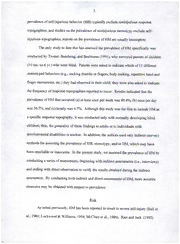
Assessment and treatment of hand mouthing : a large-scale analysis PDF
Preview Assessment and treatment of hand mouthing : a large-scale analysis
ASSESSMENTANDTREATMENTOFHANDMOUTHING: ALARGE-SCALEANALYSIS By EILEENMICHELLEROSCOE ADISSERTATIONPRESENTEDTOTHEGRADUATESCHOOL OFTHEUNIVERSITYOFFLORIDAINPARTIALFULFILLMENT OFTHEREQUIREMENTSFORTHEDEGREEOF DOCTOROFPHILOSOPHY UNIVERSITYOFFLORIDA 2001 ACKNOWLEDGMENTS Iwouldliketothankthoseindividualswhohelpedmakethisdissertation possible. First,IthankDr.BrianIwata,mycommitteechairandadvisor,forhispatience andsupportthroughoutmygraduateeducation. Hisprofessionalassistanceandadvice throughoutthisprojectandothershavebeeninvaluable. Ialsothanktheothercommittee members,Dr.JenniferAsmus,Dr.TimothyHackenberg,Dr.MarkLewis,andDr. TimothyVollmer,fortheirassistance. AdditionalthanksareextendedtoAlonzoCole, GeraldGoff,andLimingZhou,whoassistedinthedevelopmentandimplementationof thisproject. Ialsothankmyfamilyfortheirunconditionalloveandsupport. n TABLEOFCONTENTS page ACKNOWLEDGMENTS ii ABSTRACT iv INTRODUCTION 1 Prevalence 2 Risk 3 Function 5 InterventionsforBehaviorMaintainedbyAutomaticReinforcement 10 EXPERIMENT1: PREVALENCEANDRISKOFHANDMOUTHING 16 Method 16 ResultsandDiscussion 20 EXPERIMENT2: FUNCTIONALANALYSISOFHANDMOUTHING 23 Method 23 ResultsandDiscussion 24 EXPERIMENT3: TREATMENT 29 ParticipantsandSetting 30 DataCollectionandReliability 30 PhaseI: FunctionalAnalysis 30 PhaseII: PreferenceAssessments 33 ResultsandDiscussionforPhaseII 34 PhaseIII: TreatmentEvaluation 36 ResultsandDiscussionforPhaseIII 39 DISCUSSION 50 REFERENCES 54 BIOGRAPHICALSKETCH 59 iii AbstractofDissertationPresentedtotheGraduateSchool oftheUniversityofFloridainPartialFulfillmentofthe RequirementsfortheDegreeofDoctorofPhilosophy ASSESSMENTANDTREATMENTOFHANDMOUTHING: ALARGE-SCALEANALYSIS By EileenMichelleRoscoe August,2001 Chairman: BrianA.Iwata MajorDepartment: Psychology Handmouthing(HM)isachronicprobleminindividualswithdevelopmental disabilities. SomeformsofHMareclassifiedasself-injuriousbehaviorwhenlesions, tissuebreakdown,andinfectionoccur. Althoughtheprevalenceofmouthinghasbeen reported,dataonthefrequency,severity,orfunctionsofthebehaviorwerenotincluded. ThepurposeofthepresentstudywastoconductsuchananalysisofHMinalarge population. Thestudywasconductedattwopublicresidentialfacilitiesforpersonswith developmentaldisabilities,withatotalpopulationof830individuals. InExperimentI,theprevalenceandriskofHMwereassessedusingindirectand directobservationmethods. Resultsobtainedfrominterviewsshowedthattheprevalence ofHMintwoinstitutionalsampleswascomparabletothatreportedinearlierstudies, whereasdirectobservationyieldedalowerestimateofprevalence. Inaddition,results indicatedthatHM,whenitdidoccur,waslikelytoproducetissuedamageifleft untreated. IV InExperimentII,modifiedfunctionalanalyses(FAs)wereconducted,during whichalone,attention,anddemandsessionswerealternatedinmultielementdesignswith a2:1ratioofalonetoattentionanddemandsessions. Resultsindicatedthat,in98.4%of the64casesforwhichanFAwasconducted,HMwasmostlikelymaintainedby automaticreinforcement. InExperimentIII,14individualswhoseHMeitheroccurredatveryhigh-rates duringtheFAorproducedseveretissuedamagetothehandsparticipated. InPhaseI,a modifiedFAwasconductedthatdeterminedparticipants'HMwasmaintainedby automaticreinforcement. InPhaseII,preferenceassessmentswereconductedthat identifiedpreferredleisureand/oredibleitemsthatwereusedduringtreatment. InPhase III,thefollowinginterventionswereimplementedinsequentialorder:(a)noncontingent reinforcement(NCR),(b)eitherNCR+differentialreinforcementofalternativebehavior (DRA)+responseblockingorNCR+responseblockingonly,and(c)NCR+brief manualrestraint. NCR,NCR+DRA+responseblocking,NCR+responseblocking, andNCR+briefrestraintresultedinincreasesinitemcontactandlargereductionsin HM forsix,five,two,andoneparticipant(s),respectively. INTRODUCTION Thepurposeofthecurrentinvestigationwastoconductalarge-scaleassessment andtreatmentofhandmouthing,aformofbehaviorexhibitedbyindividualswith developmentaldisabilitiesthatmayormaynotbeinjurious. InExperiment1,the prevalence,frequency,andriskofHMwereassessedusingindirectand/ordirect observationalmethods. InExperiment2,amodifiedfunctionalanalysis,basedonthat describedbyIwataetal.(1982/1994a)wasconducted,toidentifytheextenttowhich participants'HMwassensitiveto(maintainedby)socialcontingencies. InExperiment3, aprogressiveseriesofinterventionswasevaluatedtodeterminewhichtreatment,or combinationoftreatments,mosteffectivelyreducedHM. Handmouthing(HM)hasbeendefinedastheplacingofoneormoredigitsofthe handpasttheplaneofthelips(Lockwood&Williams,1994),insertionofthehandinto themouthbeyondthefirstknuckle(Dorsey,Iwata,Ong,&McSween,1980),and/orany contactbetweenthehandandthemouth(Lerman&Iwata,1996). RastandJack(1992) madeadistinctionbetweenhandmouthingandthemouthingofobjects,notingthatthe formerinvolvescontactofonlythehandsandthemouth,whereasthelattermayinclude severalbehaviorsinvolvingcontactofthemouthwithotherobjects. HMis topographicallyverysimilartohandbiting,oftenmakingtheseresponses indistinguishabletoobservers. Forexample,Paisey,Whitney,andWainczak(1993) conductedacasestudyofaparticipant'sself-injuriousHM. Althoughtheauthorsnoted thattheparticipantfrequentlyengagedinhandbiting,theyonlyrecordedinstancesof HM(definedasinsertionoffingersorhandintomouth). However,basedontheir definition,occurrencesofHMmayhaveincludedinstancesofbiting. AssumingthatHM andhandbitingmaybefunctionallyequivalent(i.e.,theyarebothmaintainedbythe sameenvironmentalvariable),lumpingtheseresponsestogethermaynotprove problematic. However,iftheresponsesaremaintainedbydifferentconsequences,clear assessmentand/ortreatmentoutcomesmaybegreatlyimpeded. Giventhis,careshould betakentousedefinitionsthatallowforaccuratediscriminationsbetweenhandmouthing andhandbitingforparticipantswhoexhibitbothresponseforms. HMthatoccursatahighfrequencyand/ordurationmayresultininjury. Researchershavereportedsalivarydermatitisand/orassociatedinfectionsrequiring medicaltreatmentasaresultofparticipants'HM(Ball,Campbell,&Barkemeyer,1980; Lockwood&Williams,1994;McClure,Moss,McPeters,&Kirkpatrick,1986). HMhas alsobeenclassifiedasaformof"stereotypy"becauseitisrepetitive,hasnoapparent function,andmayinterferewithadaptivebehavior(LaGrow&Repp,1984). Regardless ofwhetheraparticipant'sHMisinjurious,itmaygreatlyimpedeher/hisqualityoflife. Mostnotably,theoffensiveodorassociatedwithHMmayserveasabarriertosocial interactions(McClureetal.,1986). Inaddition,mouthingmayinterferewiththe acquisitionofappropriatebehaviors(Balletal.,1980). Prevalence BecauseHMhasbeenclassifiedinseveraldifferentways,estimatingits prevalencehasbeendifficult. Thatis,someauthorshavedescribedHMasaself- injuriousresponseandhaveincludeditinstudiesontheprevalenceofselfinjury(Griffin etal.,1986;Maurice&Trudel,1982),whereasothershaveconsidereditaformof stereotypy(Bodfishetal.,1995;LaGrow&Repp,1984). Giventhatstudiesonthe prevalenceofself-injuriousbehavior(SIB)typicallyexcludenoninjuriousresponse topographies,andstudiesontheprevalenceofnoninjuriousstereotypyexcludeself- injurioustopographies,reportsontheprevalenceofHMareusuallyincomplete. TheonlystudytodatethathasassessedtheprevalenceofHMspecificallywas conductedbyTroster,Bambring,andBeelmann(1991),whosurveyedparentsofchildren (10mo.-to-6yr.)whowereblind. Parentswereaskedtoindicatewhichof11different stereotypedbehaviors(e.g.,suckingthumbsorfingers,bodyrocking,repetitivehandand fingermovements,etc.)theyhadobservedintheirchild;theywerealsoaskedtoindicate thefrequencyofresponsetopographiesreportedtooccur. Resultsindicatedthatthe prevalenceofHMthatoccurred(a)atleastonceperweekwas49.4%,(b)onceperday was36.5%,and(c)hourlywas4.7%. AlthoughthisstudywasthefirsttoincludeHMas aspecificresponsetopography,itwasconductedonlywithnormallydevelopingblind children;thus,thegeneralityofthesefindingstoadultsortoindividualswith developmentaldisabilitiesisunclear. Inaddition,theauthorsusedonlyindirect(survey) methodsforassessingtheprevalenceofSIB,stereotypy,and/orHM,whichmayhave beenunreliableorinaccurate. Inthepresentstudy,weassessedtheprevalenceofHMby conductingaseriesofassessments,beginningwithindirectassessments(i.e.,interviews) andendingwithdirectobservationtoverifytheresultsobtainedduringtheindirect assessment. ByconductingbothindirectanddirectassessmentsofHM,moreaccurate measuresmaybeobtainedwithrespecttoprevalence. Risk Asnotedpreviously,HMhasbeenreportedtoresultinsevereself-injury(Ballet al.,1980;Lockwood&Williams,1994;McClureetal.,1986). RastandJack (1992) notedthat,forHMtobeconsideredinjurious,mouthingshouldresultin"redorwhite hands,chappedlipsorface,orlesionsonthehandsorface"(p.1). Inaddition,they indicatedthatHM,wheninjurious,occursbothfrequentlyandforlongperiodsoftime. Basedontheirdefinitionofinjury,anadequateassessmentofriskshouldincludeboth thefrequencyandseverityofHM. Fewstudieshaveassessedthefrequencyand/ordurationofstereotypicbehaviors. Dura,Mulick,andRasnake(1987)assessedthefrequencyanddurationofvariousforms ofstereotypy,includingrhythmicmovements,bizarreposturing,self-restraint,andobject manipulation. Participants'directcarestaffwereinterviewedtodeterminewhetheror notanindividual(a)engagedineachtypeofstereotypyand(b)engagedinthe stereotypicresponsefor1min,1-to-1 min,orgreaterthan10min. Althoughassessing thedurationofHMmayproveuseful,itwasunclearwhetherthedurationreportedwas perepisode,perday,orperweek. Ifthedurationwasperepisode,itwouldhavebeen helpfultoknowhowmanyepisodesoccurredperday. Rojahn(1986)determinedtherisk ofparticipants'stereotypybyconductingasurvey,consistingofa3-pointscalefor severityanda4-pointscaleforthefrequencyofoccurrence. Schroeder,Schroeder, Smith,andDalldorf(1978)usedanindirectassessmenttodeterminetheseverityof participants'SIB. AftersocialworkersreferredindividualswhoexhibitedSIB,a pediatricianorpsychologistinterviewedthesocialworkertoassesswhethertheSIBwas severe(itoccurredatleastonceadayandhadcausedbleeding,bruises,brokenbones,or othertissuedamagethatrequiredinterventionbyamedicalstaff)ormild(thosereferrals thatwerenotsevere). Thestudiesnotedabovearenoteworthyinthattheyassessedthe frequencyand/orseverityofseveraldifferenttopographiesofSIBand/orstereotypy. However,becauseonlyindirectassessmentswereused,thereliabilityofthefindingsis uncertain. Second,noneofthestudiesreporteddataspecificallyonHM,makingit unclearifHMoftenresultsininjury. AlthoughauthorshavenotedthatHMmayresultin severetissuedamage,nostudiestodatehaveconductedasystematicassessment indicatingthedegreeofinjuryassociatedwithHM. Inthepresentstudy,wesoughtto determinetheriskofHMexclusivelybyconductingdirectobservationsofthefrequency andseverityofparticipants'HM. Function Thedevelopmentoffunctionalanalysismethodologyisbasedonover30yearsof researchindicatingthatbehaviorproblems(e.g.,aggression,noncompliance,andSIB) areoftenlearnedperformances. Thatis,theyaremaintainedbycontingenciesofpositive ornegativereinforcement. Iwata,Dorsey,Slifer,Bauman,andRichman(1982/1994a) proposedageneralmodelforassessingbehavioralsensitivitytoavarietyof contingencies. Inthisstudy,threetestconditionswereused,eachcontaininga discriminativestimulus(SD),anestablishingoperation(EO),andasourceof reinforcement. Afourthcondition,the"play"condition,wasdesignedtobeacontrol. In thesocialdisapprovalorattentioncondition,toyswerecontinuouslyavailable,andthe therapistsatinachairacrosstheroomreadingabook. Briefattentionwasdelivered contingentuponthetargetbehavior,andallotherresponseswereignored. Thiscondition servedasatestforbehaviormaintainedbysocialpositivereinforcement. Inthedemand condition,atherapistpresentedinstructionaltasks,andproblembehaviorresultedin escapefromthesetasks. ThisconditiontestedforSIBmaintainedbysocial-negative reinforcement. Inalonecondition,theparticipantwasaloneinaroom,andnomaterials werepresent. Persistenceofrespondinginthisconditionsuggestedthatproblem
